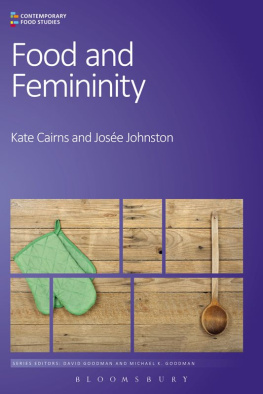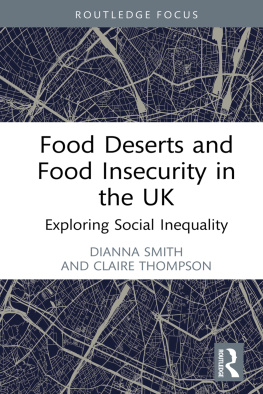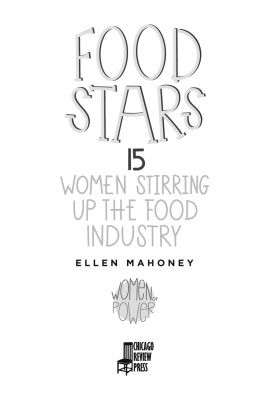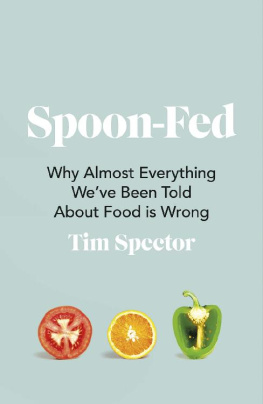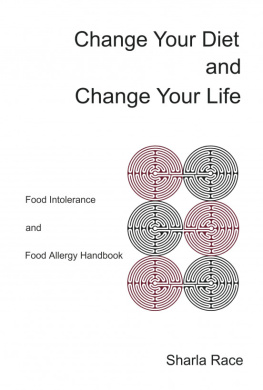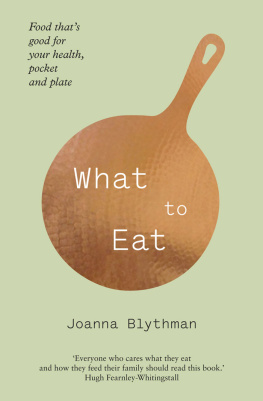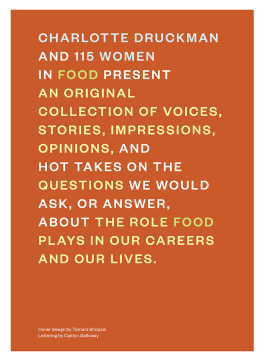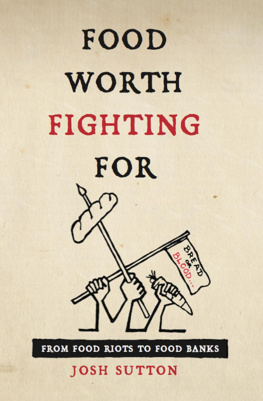Food and Femininity
Contemporary Food Studies: Economy, Culture and Politics
Series Editors: David Goodman and Michael K. Goodman
ISSN: 20581807
This interdisciplinary series represents a significant step toward unifying the study, teaching and research of food studies across the social sciences. The series features authoritative appraisals of core themes, debates and emerging research, written by leading scholars in the field. Each title offers a jargon-free introduction to upper-level undergraduate and postgraduate students in the social sciences and humanities.
Kate Cairns and Jose Johnston, Food and Femininity
Peter Jackson, Anxious Appetites: Food and Consumer Culture
Further titles forthcoming
Food and Femininity
Kate Cairns and Jose Johnston
Bloomsbury Academic
An imprint of Bloomsbury Publishing Plc

Contents
When we told people we were writing a book on food and femininity, we received a few puzzled looks. Were we doing historical research? How is such a book relevant today? We live in times of shifting gender norms when it comes to food. Male celebrity chefs dominate our television screensJamie Oliver, Gordon Ramsay, Bobby Flay, the list continues. Many people can think of a man they know who enjoys cooking or who watches what he eats to avoid gaining weight. At the same time, it is not difficult to imagine a woman who hates to cook and instead goes out for dinner. Rather than opting for salad, she may even order a big steak or a juicy burger with french fries. Prioritizing pleasure, rejecting diets, and avoiding kitchen drudgerythese all seem like options for todays women. So why write a book about something as old-fashioned as women and food?
We responded to these puzzled looks and queries with questions of our own: Who feels primarily responsible for feeding children healthy meals? Who is trying the latest juice cleanse or expressing concern for animals through veganism? Who is buying cookbooks, and managing weekly meal plans? Who is insisting on organic milk for the kids or making the trek to the weekly farmers market? There are certainly some men who do these things, but our research suggests that the answer to a lot of these questions is mainly women.
To be clear, our interest is not simply women, but femininity. By femininity, we refer to collective ideas about how to be and act feminine, and signal our gendered identity to others. We perform femininity through our clothing, physical cues, and manner of speech, but we also signal it through our food choices and the ways we relate to food. In this book, we argue that food continues to signal femininity, even if it is not the straightforward performance of the 1950s housewife. Despite the important changes that have occurred, food and femininity remain tightly intertwined in our collective imagination and in our emotional lives.
To demonstrate the connections between food and femininity, consider this thought experiment. Imagine a woman who does not appear to care about food and consider the social judgments that follow. Think of a woman who is thought to have out-of-control food habits and faces the stigma of being fat. Consider the bad mother who sends her children to school with Kraft lunchables and is seen loading bags of potato chips and frozen meals onto the grocery store conveyer belt. Imagine a woman who does not make home-cooked meals that bring her family together at the table each evening. Consider who gets blamed when a child is seen to be overweight. Picture the woman who buys cheap meat at the grocery store and is seen to be unwittingly contaminating her childrens bodies with antibiotics and growth hormones. What these examples all illustrate is that failing at food also means failing at femininity. Womens food choices continue to be closely examined under the social microscope and are harshly judged when they are deemed inadequate or ill-informed.
Parsing the enduring connections between food and femininity is not easy at a time when most people endorse gender equality and women are seen as empowered consumers able to make savvy and independent food choices. A postfeminist sensibility suggests that womens oppression is a thing of the past, which leaves women to manage food-related pressures in their individual lives. One of the key issues we hope to convey in this book is that many seemingly personal food struggles and stresses arise from the social challenge of successfully performing food femininities: the nurturing mother, the talented home-cook, the conscientious consumer, the health-savvy eater. These are not easy tasks to pull off, especially if one wants to achieve them in a relaxed, seemingly effortless way that avoids the impression of excess. As we show in the pages that follow, women are also judged harshly for caring too much about food: think here of the puritanical vegetarian, the joy-killing health nut, or the overprotective mother.
It appears that there is a relatively narrow band of acceptable food behaviors for todays women: successful food femininities involve considerable investments in good food practices while simultaneously avoiding the impression that one is a neurotic dieter or a preachy food zealot. As a result, even the most privileged women we spoke with (women with stable middle-class incomes and racial privilege) did not feel as though they were doing their absolute best when it came to food. They worried about whether they were making the right food choices to sustain the planets ecosystem and about whether their family diet had caused their childs health problems. They worried about socializing their children to develop healthy and adventurous eating habits and about the equitable division of foodwork in their intimate relationships. Collectively these worries suggest that food is essential to understanding femininity and that this is a topic laden with intense emotions for many women.
As feminist scholars, we believe it is important to briefly situate ourselves within the story we are telling in this book. Even as we look critically at the interplay between food and femininity, we are not outside of these processesour own identities are deeply bound up in the issues that we study. For instance, while conducting discourse analysis of food media for this book, Kate recalls subconsciously patting herself on the back when she discovered that her own lunch included quinoa and kaletwo of the superfoods praised in the article she was analyzing. Clearly, feminine food ideals have a seductive pull, despite our critical reflexivity toward these ideals in our work. Indeed, Jose can think critically about the association between femininity and sweet foods (see Lupton 1996: 1045), but she continues to experience satisfaction from baking, especially when she discovers a new DIY trick (e.g., homemade marshmallows). In our meetings, we invariably worked alongside a plate of Joses latest baked treat, a trend that struck us both as funny and as a reminder of our own investment in particular food femininities. (Thank you Deb Perlman, of Smitten Kitchen, for your amazing granola bar recipe!)
Food and femininity have long been bound up in our lives. For Jose, the pressure to perform femininity through food has felt both attractive and fatiguing, especially given the example she was shown as a child. Her mother performed femininity through traditional foodwork that was extremely labor-intensive: grinding her own flour for homemade bread, planting a giant garden, cooking virtually everything from scratch (including yoghurt and pasta), and hosting large meals in a seemingly effortless, relaxed manner. Growing up, Jose learned a lot about food, gardening, and cooking, but she still wonders how it is possible to host a large holiday dinner in a way that is not exhausting. By contrast, growing up in a house with two working moms, Kate was exposed at an early age to nontraditional ideas about how foodwork can be shared within the home. She started making her own lunch at the age of ten and learned early on about the importance of feeding herself. Kate does not feel the pressure to cook elaborate dinners from scratchshe regularly (and happily) makes quick and easy meals. Even still, food is important to her identity, including the fact that she has been a vegetarian for ten years.
Next page
